
Looking for How to Make simple Blueberry vinaigrette - Easily! With Step-by-step Directions, Photos, Ingredients, Recipe and Costs in 2025? Scroll down this page and follow the links. And if you bring home some fruit or vegetables and want to can, freeze, make jam, salsa or pickles, see this page for simple, reliable, illustrated canning, freezing or preserving directions. There are plenty of other related resources, click on the resources dropdown above. If you are having a hard time finding canning lids, I've used these, and they're a great price & ship in 2 days.
If you have questions or feedback, please let me know! There are affiliate links on this page. Read our disclosure policy to learn more.
How to Make simple Blueberry vinaigrette - Easily! With Step-by-step Directions, Photos, Ingredients, Recipe and Costs
Yield: 4 eight-ounce jars
Click here for a PDF print version
Making and canning your own Blueberry Vinaigrette salad dressing is possible; if you follow these simple directions and understand the limitations of home canning. For example, simple fruit vinaigrettes may be safely caned at home, but dressings with oils, milks, creams, eggs, etc. cannot be safely canned at home.
The key is you add the oil when you go to use each jar. Home canning of foods with added vegetable or olive oils is dangerous, as it is a perfect environment for botulism, so instead, we leave out the oil. You can add as much oil to it when you open the jars and use the vinaigrette!
Ingredients
- 2 cups of fresh or frozen blueberries
- 4 cups of red wine vinegar
- zest of 1 lemon (or 3 tablespoons of lemon juice, if you are zestless )
- 2 tablespoons of finely minced Chipotle Peppers in adobe sauce (optional)
- 2 tablespoons minced garlic (optional)
Equipment
- At least 1 large pot; I prefer 16 to 20 quart pots for easy cleanup.
- Large spoons and ladles,
- 1 Water Bath Canner (a huge pot to sanitize the jars after filling (about $30 to $35 at mall kitchen stores, sometimes at big box stores and grocery stores.). Note: we sell canners and supplies here, too - at excellent prices - and it helps support this web site!
- Half pint canning jars (Grocery stores, like Publix, Kroger, Safeway carry them, as do some big box stores - about $7 per dozen 8 ounce jars including the lids and rings)
- Lids - thin, flat, round metal lids with a gum binder that seals them against the top of the jar. They may only be used once.
- Rings - metal bands that secure the lids to the jars. They may be reused many times.
- Jar funnel ($5 at Target, other big box stores, and often grocery stores; and available online - see this page) or order it as part of the kit with the Jar grabber .
- Jar grabber (to pick up the hot jars)- Big box stores and grocery stores sometimes carry them; and it is available online - see this page. It's a tremendously useful to put jars in the canner and take the hot jars out (without scalding yourself!). The kit sold below has everything you need, and at a pretty good price
Directions - Step by Step
Step 1 - Pick the berries! (or buy them already picked))
It's fun to go pick your own and you can obviously get better quality ones!
I prefer to grow my own; which is
really easy -
but that does take some space and time.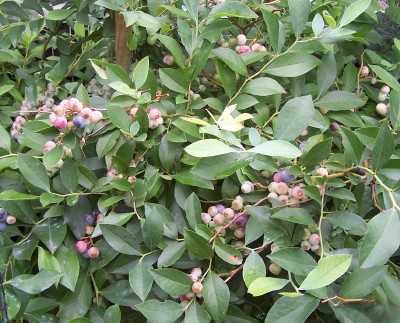
As mentioned in the Ingredients section; you may use frozen blueberries (those without syrup or added sugar); which is especially useful if you want to make some jelly in December to give away at Christmas!
At left are blueberries (in my yard, actually; they make a great hedge or landscaping bush) almost ripe! If you want to pick your own, here is a list and links to the pick your own farms.
If you are starting out with blueberry juice (canned, fresh or frozen), just skip straight to step 8.
How much fruit?
Blueberry Vinaigrette can be made in any size batch, so this can be scaled up or down! This recipe yields about 2 pints (4 eight-ounce jars)
Step 2 - Wash the jars and lids
 Now's a good time to get the jars ready, so you won't be rushed later. The dishwasher is fine for the jars; especially if it has a "sanitize" cycle, the water bath processing will sanitize them as well as the contents! If you don't have a dishwasher with a sanitize cycle, you can wash the containers in hot, soapy water and rinse, then sanitize the jars by boiling them 10 minutes, and keep the jars in hot water until they are used.
Now's a good time to get the jars ready, so you won't be rushed later. The dishwasher is fine for the jars; especially if it has a "sanitize" cycle, the water bath processing will sanitize them as well as the contents! If you don't have a dishwasher with a sanitize cycle, you can wash the containers in hot, soapy water and rinse, then sanitize the jars by boiling them 10 minutes, and keep the jars in hot water until they are used.
NOTE: If a canning recipe calls for 10 minutes or more of process time in the canner, then the jars do not need to be "sanitized" before filling them. But really, sanitizing them first is just good hygeine and common sense! See this page for more detail about cleaning and sanitizing jars and lids.
Put the lids into a pan of hot, but not quite boiling water (that's what the manufacturer's recommend) for 10 minutes, and use the magnetic "lid lifter wand" to pull them out. Leave the jars in the dishwasher on "heated dry" until you are ready to use them. Keeping them hot will prevent the jars from breaking when you fill them with the hot Blueberry Vinaigrette.
Step 3 -Wash the blueberries and sort!
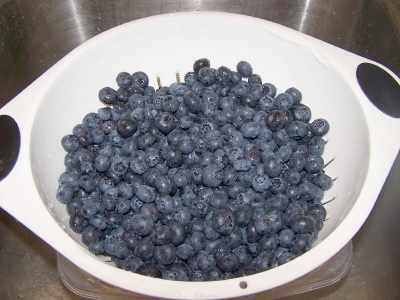 I'm sure you can figure out how to wash the fruit in a
colander of plain
cold water.
I'm sure you can figure out how to wash the fruit in a
colander of plain
cold water.
 Then you need to pick out and remove any bits of stems, leaves and soft
or mushy blueberries. It is easiest to do this in a large bowl of water and
gently run your hands through the blueberries as they float. With your
fingers slightly apart, you will easily feel any soft or mushy
blueberries
get caught in your fingers.
Then you need to pick out and remove any bits of stems, leaves and soft
or mushy blueberries. It is easiest to do this in a large bowl of water and
gently run your hands through the blueberries as they float. With your
fingers slightly apart, you will easily feel any soft or mushy
blueberries
get caught in your fingers.
Then just drain off the water!
Step 4 - Crush the blueberries
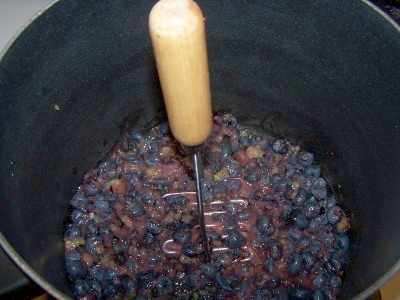 You can go wild, be a conquering Genghis Khan crushing the peasants..
watch them flee. Well, if they're not fleeing, the blueberries sure do manage
to roll everywhere. You won't find them until the next time you clean
behind your refrigerator!
You can go wild, be a conquering Genghis Khan crushing the peasants..
watch them flee. Well, if they're not fleeing, the blueberries sure do manage
to roll everywhere. You won't find them until the next time you clean
behind your refrigerator!
Anyway, to crush them, you can either do one layer at
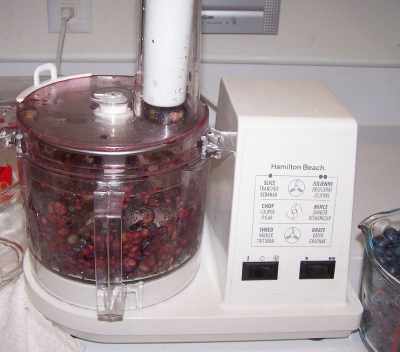 a time in a pan or
bowl, using a potato masher..
a time in a pan or
bowl, using a potato masher..
OR
you can be lazy like me and use the slice mode on your food processor. If
you have a juicer, you can use that instead!

Step 5 - Optional: Puree the chipotle in adobe sauce with the garlic and vinegar
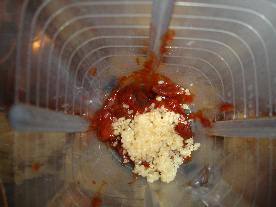 If
you want a bit of spicy flavor, puree
the 2 tablespoons of Chipotle Peppers in adobe sauce with 2 ta
If
you want a bit of spicy flavor, puree
the 2 tablespoons of Chipotle Peppers in adobe sauce with 2 ta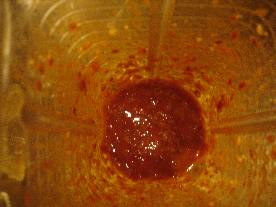 blespoons
minced garlic and 1/3 cup red wine vinegar in a blender, food processor or
electric chopper, then add to the blueberries and vinegar in Step 7.
blespoons
minced garlic and 1/3 cup red wine vinegar in a blender, food processor or
electric chopper, then add to the blueberries and vinegar in Step 7.
Step 6 - Get the lids warming in hot (but not boiling) water
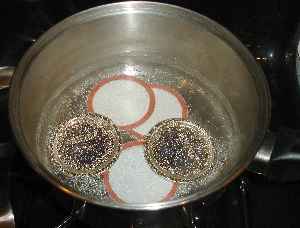 Lids: put the lids into a pan of hot water for at least several minutes; to soften up the gummed surface and clean the lids.
Lids: put the lids into a pan of hot water for at least several minutes; to soften up the gummed surface and clean the lids.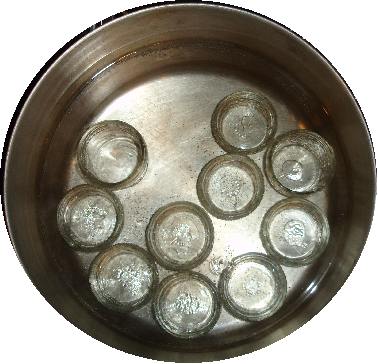 Do the same with the jars (just put them in the canner until you are ready to
fill them).
Do the same with the jars (just put them in the canner until you are ready to
fill them).
Need lids, rings and replacement jars?
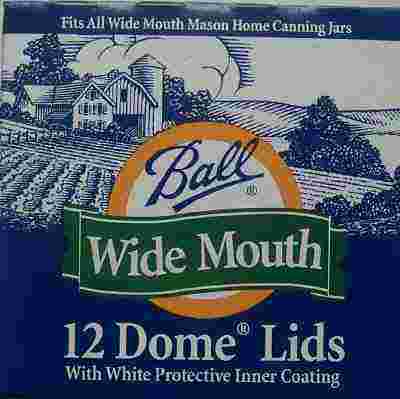

 Get them all here, delivered direct to your home, at the best prices on the internet!
Get them all here, delivered direct to your home, at the best prices on the internet!
Step 7 - Mix the berries with the vinegar and heat to a full boil
 Stir the
blueberries, vinegar (or remaining vinegar), lemon zest or juice and blended chipotle mix
(if you chose to add it) in a big pot on the stove over medium
to high heat (stir often enough to prevent burning). Just bring
the mix to a boil, then remove from the heat.
Stir the
blueberries, vinegar (or remaining vinegar), lemon zest or juice and blended chipotle mix
(if you chose to add it) in a big pot on the stove over medium
to high heat (stir often enough to prevent burning). Just bring
the mix to a boil, then remove from the heat.
Step 8 - Fill the jars and put the lid and rings on
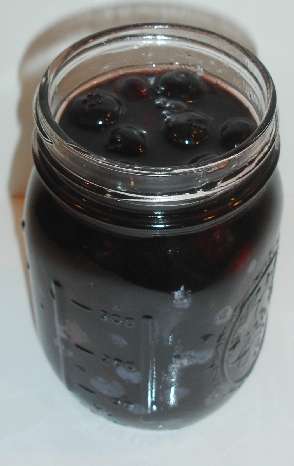 Fill them to within 1/4-inch of the top, wipe any spilled
sauce off the top, seat the lid and tighten the ring around them. Then put the filled jars into the canner!
Fill them to within 1/4-inch of the top, wipe any spilled
sauce off the top, seat the lid and tighten the ring around them. Then put the filled jars into the canner!
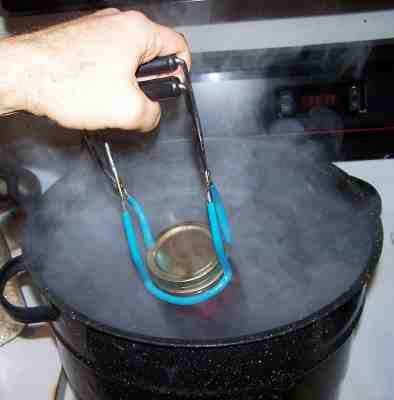
This is where the jar tongs come in really handy!
Step 9 - Process the jars in the boiling water bath
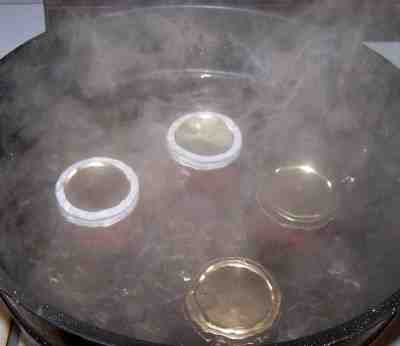 Keep the jars covered with at least 2 inches of water. Keep the water boiling.
Boil them for 5 minutes. See the chart below for altitude adjustment to processing times, if you are not in the sea level to 1,000ft above sea level range.
Keep the jars covered with at least 2 inches of water. Keep the water boiling.
Boil them for 5 minutes. See the chart below for altitude adjustment to processing times, if you are not in the sea level to 1,000ft above sea level range.
Note: Some people don't even boil the jars; they just ladle it hot into hot jars, put the lids and rings on and invert them - no credible authority (FDA, USDA, major universities food sciences departments, recommend this. Putting the jars in the boiling water bath REALLY helps to reduce spoilage! To me, it makes little sense to put all the working into making the sauce and then not to process the jars to be sure they don't spoil!
Recommended process time for Blueberry Vinaigrette in a boiling water canner. | ||||
| Process Time at Altitudes of | ||||
| Style of Pack | Jar Size | 0 - 1,000 ft | 1,001 - 6,000 ft | Above 6,000 ft |
| Hot | Half-pints or Pints | 10 min | 15 | 20 |
Step 10 - Remove and cool the jars - Done!
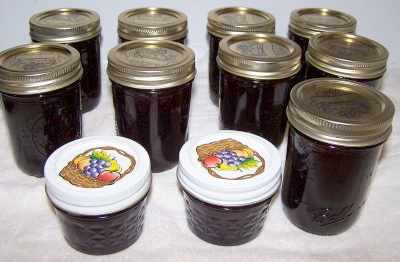 Lift the jars out of the water with your jar lifter tongs and let them cool without touching or bumping them in a draft-free place (usually takes overnight) You can then remove the rings if you like, but if you leave them on, at least loosen them quite a bit, so they don't rust in place due to trapped moisture. Once the jars are cool, you can check that they are sealed verifying that the lid has been sucked down. Just press in the center, gently, with your finger. If it pops up and down (often making a popping sound), it is not sealed. If you put the jar in the refrigerator right away, you can still use it. Some people replace the lid and reprocess the jar, then that's a bit iffy. If you heat the contents back up, re-jar them (with a new lid) and the full time in the canner, it's usually ok.
Lift the jars out of the water with your jar lifter tongs and let them cool without touching or bumping them in a draft-free place (usually takes overnight) You can then remove the rings if you like, but if you leave them on, at least loosen them quite a bit, so they don't rust in place due to trapped moisture. Once the jars are cool, you can check that they are sealed verifying that the lid has been sucked down. Just press in the center, gently, with your finger. If it pops up and down (often making a popping sound), it is not sealed. If you put the jar in the refrigerator right away, you can still use it. Some people replace the lid and reprocess the jar, then that's a bit iffy. If you heat the contents back up, re-jar them (with a new lid) and the full time in the canner, it's usually ok.
Once cooled, they're ready to store. I find they last up to 18 months. They still are safe to eat after that, but the flavor and texture aren't as good. So eat them in the first year or so after you prepare them! Another trick is to keep the uncooked berries or other fruit in the freezer and make and can the sauce as needed, so it's always fresh.
Other Equipment:From left to right:
|  You can get all of the tools in a kit here: Canning kit with Stainless Steel Steam Rack,Canning Funnel, Jar Lifter, Jar Wrench, Lid Lifter, Canning Tongs, Bubble Remover Tool |
Summary - Typical Cost of Making Homemade Vinaigrette - makes 8 jars, 8 oz each** | ||||
| Item | Quantity | Cost in 2025 | Source | Subtotal |
| Berries (raspberries) | 2 cups | $8.00/gallon | Pick your own | $1.00 |
| Canning jars (8 oz size), includes lids and rings | 4 jars | $11/dozen 8 oz jars or $0.92/jar | Grocery stores, like Public, Kroger, Safeway and sometimes, Big Lots, local hardware stores and big box stores | $2.33 |
| Vinegar | 4 cups | $1.00 | Grocery stores, like Public, Kroger, Safeway and sometimes, Big Lots, local hardware stores and big box stores | $1.00 |
| Seasonings | trivia | Grocery stores, like Public, Kroger, Safeway and sometimes, Big Lots, local hardware stores and big box stores | $1.00 | |
| Total | $5.33 total or about $1.33 per jar | |||
| ** - This assumes you already have the pots, pans, ladles,, and reusable equipment. Note that you can reuse the jars and reduce the cost further; just buy new lids (the rings are reusable, but the flat lids are not)! | ||||
Can't find the equipment? We ship to all 50 states!
Use our Feedback form!
This document was adapted from the the Ball Blue Book's fruit vinegar recipes
FAQs - Answers to Common Questions
-
As my jars are cooling after i take them out of the canner, they sometimes make a popping or hissing noise. Is this normal and safe?
Yes, the lids are designed to flex and that's actually a key selling point. You can tell if a jar hasn't sealed properly (after it has cooled completely) if the lid flexes and makes a popping sound when you press the center of the lid with your finger. The popping sounds while it is cooling is the lid being sucked down by the vacuum that is forming inside the jar - which a normal part of the sealing process. Hissing sounds are usually just escaping steam or hot water evaporating on hot surfaces, also normal! - Why should cooked jelly be made in small batches?
If a larger quantity of juice is used, it will be necessary to boil it longer thus causing loss of flavor, darkening of jelly, and toughening of jelly. It really doesn't work. Trust me; I've tried many times! - Can I use frozen berries instead of fresh?
Yep! Blueberries can be particularly hard to find fresh and are expensive! Frozen berries work just fine, and measure the same. Just be sure to get the loose, frozen whole fruit; not those that have been mushed up or frozen in a sugar syrup! - Should jelly be boiled slowly or rapidly?
It should be boiled rapidly since long, slow boiling destroys the pectin in the fruit juice. - What do I do if there's mold on my jellied fruit product?
Discard Blueberry Vinaigrettes and jellies with mold on them. The mold could be producing a mycotoxin (poisonous substance that can make you sick). USDA and microbiologists recommend against scooping out the mold and using the remaining sauce or jelly. - Why did my jellied fruit product ferment, and what do I do?
Jellied fruit products may ferment because of yeast growth. This can occur if the product is improperly processed and sealed, or if the sugar content is low. Fermented fruit products have a disagreeable taste. Discard them. - What happens if my
sauce or jelly doesn't gel?
Remaking cooked runny sauce or jelly instructions can be found on this page - Could you tell me why my SAUCE is thicker then the store bought?
The natural pectin content of fresh fruit varies, so it is possible the the variety of fruit that you used has more natural pectin, making it thicker. But there's an easy answer - ju
st add less pectin next time. You will have to experiment to find how much pectin makes the consistency you like. Most people seem to like their sauce thick, so you may to need to only use 3/4 of a pack of pectin per batch. - What is the best way to deseed berries for sauce? I heard a few different
ways. A food mill, a ricer, and cheese cloth.
For large seeds (blackberries, apples, and larger) I find a Foley Food Mill works best - it's certainly faster and easier than the other methods. Raspberry and smaller seeds are a real pain. They get stuck in (and clog) or pass through a food mill. The Villaware mill has a smaller screen that works great for them! See this page for more information about both strainers. Cheesecloth and jelly strainers are messy, take forever and you lose most of the pulp. For these, I find a metal sieve or colander (with small enough holes) and a spatula to help mush them and push the pulp through, is best. Also, heating the mushed up berries almost to boiling really helps to separate the seeds and pulp. - Click here to see our complete list of frequently asked questions on this page!
Comments and Feedback
Illustrated Canning, Freezing, Jam Instructions and Recipes
[ Easy Home Canning Directions] [FAQs - Answers to common questions and problems] [Recommended books about home canning, jam making, drying and preserving!] [Free canning publications to download and print]
Looking for canning equipment and supplies?
Water bath canner with a jar rack
Pressure canners for gas, electric and induction stoves: Presto 23Qt or T-fal 22Qt
Canning scoop (this one is PERFECT)
Ball Blue book (most recent version)
Jars: 8oz canning jars for jams
Find Other types of farms:
Farm markets and roadside stands
Road trips and camping resources
Local Honey, apiaries, beekeepers
Consumer fraud and scams information
Home canning supplies at the best prices on the internet!
Maple Syrup Farms, sugarworks, maple syrup festivals
Environmental information and resources
Farms For Your Event for birthday parties, weddings, receptions, business meetings, retreats, etc.
Festivals - local fruit and vegetable festivals
Get the
most recent version of
the Ball Blue Book
With this Presto 23 quart pressure canner and pressure cooker, you can "can" everything, fruits, vegetables, jams, jellies, salsa, applesauce, pickles, even meats, soups, stews. Model 01781

You can make jams, jellies, can fruit, applesauce, salsa and pickles with water bath canners, like this Granite Ware 12-Piece Canner Kit, Jar Rack, Blancher, Colander and 5 piece Canning Tool Set

